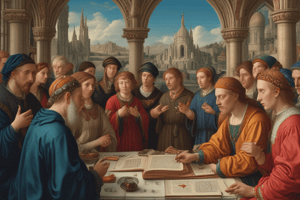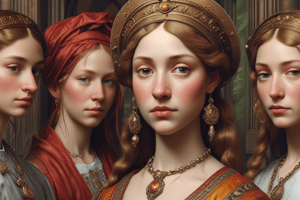Podcast
Questions and Answers
What was the key to wealth and power in the Middle Ages?
What was the key to wealth and power in the Middle Ages?
Land
The king's land was always larger than a noble's land.
The king's land was always larger than a noble's land.
False (B)
What system was known for giving land in return for loyalty or service?
What system was known for giving land in return for loyalty or service?
Feudal system
Which group of individuals had become more powerful during the Renaissance?
Which group of individuals had become more powerful during the Renaissance?
What was the primary duty of knights in the Renaissance social structure?
What was the primary duty of knights in the Renaissance social structure?
Who were the majority of people in Renaissance society?
Who were the majority of people in Renaissance society?
What led to significant social changes during the Renaissance?
What led to significant social changes during the Renaissance?
The population increased significantly after AD 1100 due to general peace.
The population increased significantly after AD 1100 due to general peace.
The Church owned about _____ of all farmland in Europe.
The Church owned about _____ of all farmland in Europe.
What caused a rise in the middle class during the Renaissance?
What caused a rise in the middle class during the Renaissance?
During the Renaissance, what happened to serfdom?
During the Renaissance, what happened to serfdom?
What characterized the new middle class that emerged after the Black Death?
What characterized the new middle class that emerged after the Black Death?
What was the lowest social class during the Renaissance?
What was the lowest social class during the Renaissance?
Match the following factors with their impact on the Renaissance:
Match the following factors with their impact on the Renaissance:
Flashcards are hidden until you start studying
Study Notes
Class Structure of the Renaissance Era
- Land was central to wealth and power during the Middle Ages, controlled from castles, with a hierarchical structure led by the king and nobles.
- The king owned all land theoretically but divided it among nobles who pledged loyalty and protection in return, exemplifying the feudal system.
- Despite being kings, rulers often held land less extensive than that of powerful nobles, illustrating the relative weakness of monarchy.
- The Church gained substantial power, owning about 20% of farmland in Europe and collecting taxes from Christians, rivaling royal authority.
- The Pope appointed high-ranking Church officials, establishing significant influence over various regions, further augmenting the Church's power.
Roles Within Society
- Knights were skilled combatants serving nobles in exchange for land, loyalty, and protection, but they were wealthier than peasants yet below nobles.
- The majority of society comprised farmers, including many unfree serfs, who worked under the control of lords and were vital to the labor force.
- Various workers, including blacksmiths and craftsmen, operated within castles, contributing to the economy.
Transition from Feudalism to the Renaissance
- By AD 1100, feudalism began to decline, prompting significant social changes; national monarchies started to rise in western Europe, beginning around 1300.
- A population increase occurred following earlier low levels due to wars, fueled by relative peace beginning from AD 1100.
- Improvements in agriculture led to increased farming output, as peace allowed for the opening of more land and better farming techniques.
- Urbanization grew as people focused less on food security and more on trade, leading to a rise in towns and the emergence of guilds that regulated industries.
Economic Developments
- Trade expanded in Europe with Italian merchants dominating external trade while regional merchants facilitated internal trade, stimulating economic activity and increasing the use of money.
- The middle class, consisting of merchants and craftsmen, gained power and autonomy, enjoying more rights than peasants by 1300, fostering social equality.
Impact of the Bubonic Plague
- The "Black Death" devastated Europe's population (1350-1450), significantly altering social structures and economic conditions, particularly in urban areas.
- The plague caused a labor shortage, resulting in rising wages, enhanced living standards for many peasants, and the decline of serfdom.
- Wealthy merchant families, like the Medici, flourished post-plague, providing finances that spearheaded Renaissance cultural advancements.
Social Classes during the Renaissance
- The Renaissance social structure consisted of nobles, merchants, middle-class professionals, and urban workers, each with varying degrees of wealth and influence.
- Nobles maintained wealth and land ownership, often living in luxury and investing in the arts, while previously contemptuous of merchants, they began to intermarry with them for economic gain.
- Merchants became a powerful new class, amassing wealth through trade and industry, influencing governance, and supporting artists to improve their social standing.
- The middle class, comprising shopkeepers and professionals, thrived amid the transformation, while urban workers, despite a precarious position, found better living conditions than rural peasants.
Studying That Suits You
Use AI to generate personalized quizzes and flashcards to suit your learning preferences.




